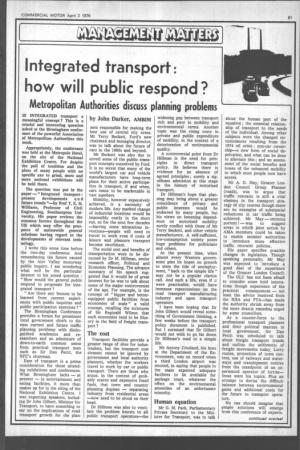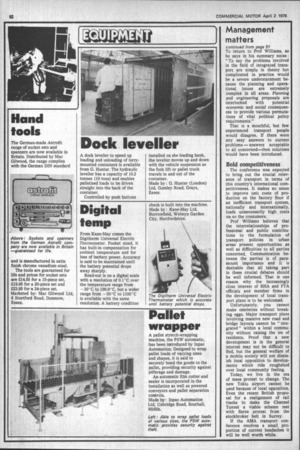Integrated transport: how will public respond?
Page 53

Page 54

If you've noticed an error in this article please click here to report it so we can fix it.
Metropolitan Authorities discuss planning problems
by John Darker, AMBIM
IS INTEGRATED transport a meaningful concept ? This is a crucial and interesting question asked at the Birmingham conference of the powerful Association of Metropolitan Authorities this week.
Appropriately, the conference was held at the Metropole Hotel, on the site of the National Exhibition Centre. For despite the pull of tradition and the pleas of many people with no specific axe to grind, more and more national exhibitions will be held there.
The question was put in the paper — "Integrated transport : present developments a n d future trends "—by Prof T. E. H. Williams, Professor of Civil Engineering, Southampton University. His paper reviews the common factors throughout the UK which may offer the prospects of nationwide general solutions having regard to the developments of relevant technology.
I write this some time before the two-day conference. And remembering the furore caused by the Aire Valley motorway public inquiry, I am wondering what will be the particular interest to his posed question " How would the general public respond to proposals for integrated transport ?
"Are there any lessons to be learned from current experiences with public inquiries and public participation exercises ?"
The Birmingham Conference provides a forum for prominent local government chiefs to discuss current and future traffic planning problems with distinguished academics and researchers and an admixture of down-to-earth common sense from practical transport men such as Sir Dan Pettit, the NFC's chairman.
Ease of transport is a prime consideration for those attending exhibitions and conferences. What Birmingham lacks — at present — in entertainment and eating facilities, it more than makes up for in the siting of the National Exhibition Centre. I was expecting speakers, including Dr John Gilbert, Minister for Transport, to have something to say on the implications of road transport growth for the plan ners responsible for making the best use of central city areas. Mr Terry Beckett, Ford's new chairman and managing director, vvas to talk about the future of cars in the 1980s and beyond.
Mr Beckett was also due to unveil some of the public transport concepts conceived by Ford. It is no secret that many of the world's largest car and vehicle manufacturers have long-term plans for their active participation in transport, if and when, cars cease to be marketable in vast numbers.
Mobility, however expensively achieved, is a necessity of modern life. Any marked change of industrial locations would be impossibly costly in the short run, so for the next few decades —barring some miraculous inventions—people will need to travel to work even if costs of leisure and pleasure transport become exorbitant.
The social cost and benefits of transportation were to be discussed by Dr M. Hillman, senior research officer, Political and Economic Planning. The advance summary of his speech suggested that it would be of great interest for he was to talk about some of the major controversies of the age. For example, is the concept of "bigger and betterequipped public facilities from economies of scale" a valid concept, recalling the strictures of Sir Reginald Wilson that such economies tend to be illusory in the field of freight transport ?
The cost
Transport facilities provide a greater range of sites for industrialists, but the transport cost element cannot be ignored by government. and local authority planners, whether the workers travel to work by car or public transport. There are those who argue, in the context of probably scarce and expensive fossil fuels, that town and country planning dogmas — separating industry from residential areas —now need to be stood on their head.
Dr Hillman was also to ventilate the problem known to all public transport operators—the widening gap between transport rich and poor in mobility and environmental terms. Another topic was the rising costs in private and public expenditure of mobility, in the context of a deterioration of environmental quality.
A controversial point from Dr Hillman is the need for principles to direct transport policy. He believes there is evidence for an absence of agreed principles ; surely a significant admission at this stage in the history of motorised transport.
Dr Hillman's hope that planning may bring about a greater coincidence of private and public interests would be endorsed by many people, but his views on lessening dependence on motorised mobility surely conflict with those of Mr Terry Beckett, and other vehicle manufacturers, A self-sufficient, low-consumption society poses huge problems for politicians and others.
At the present time, when almost every Western government pins its hopes on growth to stem the tide of unemployment, "back to the simple life " may not be a popular clarion call. And such a life, even if a. were practicable, would have immense repercussions on the road transport manufacturing industry and upon transport operators.
I have been hoping that Dr John Gilbert would reveal something of Government thinking, a few weeks before the transport policy document is published. But I surmised that Dr Gilbert would not wish to go far down Dr Hillman's road to a simple life.
Mr Antony Crosland, his boss at the Department of the Environment, was on record when a third London airport was mooted, in saying that people in the mass expected adequate facilities to be available for package tours, whatever the effect on the environmental amenities of an unfortunate minority.
Human equation
Mr G. M. Park, Parliamentary Private Secretary to the Minister for Transport, was to talk about the human part of the equation ; the essential relationship of transport to the needs of the individual. Among other subjects were the changed circumstances resulting from the 1974 oil crisis ; non-car ownership—a new form of social deprivation, and what can be done to alleviate this ; and an assessment of the social benefits and losses of the enhanced mobility to which most people now have access.
Mr A. D. May, Greater London Council Group Planner (roads), was to argue that traffic restraint is still a vital element in the transport strategy of city centres though there are no examples of substantial reductions in car traffic being achieved. Mr May — ominous
portent ! — was to suggest areas in which joint action by AMA members could be taken to enable member authorities to introduce more effective traffic restraint policies.
His paper specifies possible changes in legislation. Though speaking personally, Mr May was expected to introduce a good deal of the experience of the Greater London Council.
The GLC has not been afraid to consider some bold innovations though experience of the practical consequences — not least the advice received from the RHA and FTA—has made the authority shrink away from the more drastic remedies urged by some councillors.
As a counter-force to the professional transport planners and their political masters in local government, Sir Dan Pettit was scheduled to talk about freight transport trends and outline the arithmetic of freight movements today. Lorry routes, protection of town centres, use of railways and waterways and transhipment centres from the standpoint of an experienced operator of lorries— these were his topics. Plus an attempt to devise the difficult balance between environmental gains and additional costs for the future to transport operators.
No one should imagine that simple solutions will emerge from this conference of experts. To return to Prof Williams, as he says in his summary notes : " To say the problems involved in the field of integrated transport are simple in theory but complicated in practice would be a severe understatement because the planning and operational issues are extremely complex in all areas. Planning and engineering proposals are interlocked with potential economic and social consequences to provide various permutations of vital political policy requirements."
That is a mouthful, but few experienced transport people would disagree. If there were any easy answers to current problems — answers acceptable to all concerned—then solutions would have been introduced.
Bold competitiveness
The conference was expected to bring out the crucial relevance of transport in terms of this country's international competitiveness. It makes no sense to improve unit costs of production on the factory floor if an inefficient transport system, nationally and internationally, loads unnecessarily high costs on to the consumers.
Prof Williams believes that the interrelationships of professional and public contributions to the formulation of transport policies in urban areas present opportunities as well as difficulties to all parties concerned. Communication between the parties is of paramount importance and it is desirable that all taking part in these crucial debates should be well informed. That is one reason why the increasingly close interest of RHA and FTA officials and member firms in the development of local transport plans is to be welcomed.
Unfortunately, you cannot make omelettes without breaking eggs. Major transport plans involving massive new road and bridge layouts cannot be " integrated " within a local community without raising the ire of residents. Proof that a new development is in the general interest may not be difficult to find, but the general welfare of a mobile society will not diminish local opposition to developments which ride roughshod over local community feeling.
Today, we live in the era of mass protest to change. The new Tokio airport cannot be used because of local opposition. Even the recent British proposal for a realignment of rail tracks to make the Channel Tunnel a viable scheme met with fierce protest from the stockbroker belt in Surrey.
If the AMA transport • conference resolves a small proportion of current headaches it will be well worth while.




























































































